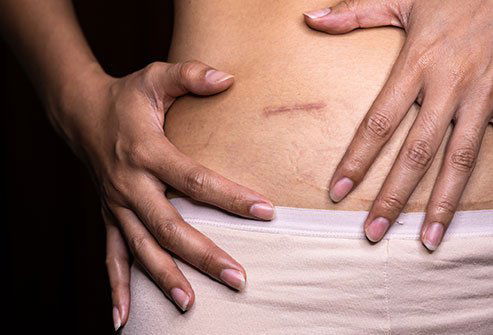Scar Tissue

Scar tissue (adhesions)
Adhesions are bands of scar tissue that form during healing from pelvic surgery, infection or endometriosis. Although the formation of scar tissue is a normal part of the healing process, adhesions can be problematic because they cause parts of the body that are not normally connected to stick to each other. For example, the intestine may become connected by adhesions to the uterus, or the fallopian tube may stick to the ovary. Scar tissue is very tough and lacks the flexibility and elasticity of normal tissue. Thus, adhesions impair the normal movement of the pelvic organs and can cause pain.
The formation of adhesions in women who have gynecologic surgery is very common; in fact, 90% of all women who undergo gynecologic surgery are at risk for forming adhesions. Adhesions do not always cause pain or other problems. However, in some cases they can be a complication requiring further surgery.
When adhesions form inside the uterus (intrauterine adhesions), they can interfere with normal periods, fertility or pregnancy. In women who have had endometrial ablation, intrauterine adhesions may mask or obstruct bleeding from any endometrial tissue that remains or regenerates, and this may cause pain and other problems. When adhesions form between the uterus and the intestine, they can lead to bowel obstruction.
Prevention
The risk of forming adhesions can be reduced with the use of materials that have been developed to prevent adjacent tissues from sticking to each other. One type is a cloth like material and the other is a gel; both dissolve after a few weeks.
Additionally, some evidence suggests that adhesion formation is reduced when surgery is performed laparoscopically.
Treatment
When adhesions are severe and painful or cause other health problems, they can be removed surgically. In the past this was done using open abdominal surgery, but today it is more often done using laparoscopic surgery because of the reduced trauma to the body.
References
- American Society for Reproductive Medicine. Patient’s Fact Sheet: Intrauterine Adhesions. www.asrm.org/Patients/FactSheets/Intrauterine_Adhesions-Fact.pdf
- Bulletti C. Adhesion formation after laparoscopic myomectomy. J Am Assoc Gynecolog Laparoscopists. 1996;3:533-36.
- McCausland AM, et al. Long-term complications of endometrial ablation: Cause, diagnosis, treatment, and prevention. J Min Invasive Gynecology. 2007;14:399-406.
- National Women’s Health Resource Center, Inc. Your Guide to Uterine Health. www.healthywomen.org
- Parker WH. A Gynecologist’s Second Opinion. ©2003; A Plume Book; Published by the Penguin Group, New York, NY.